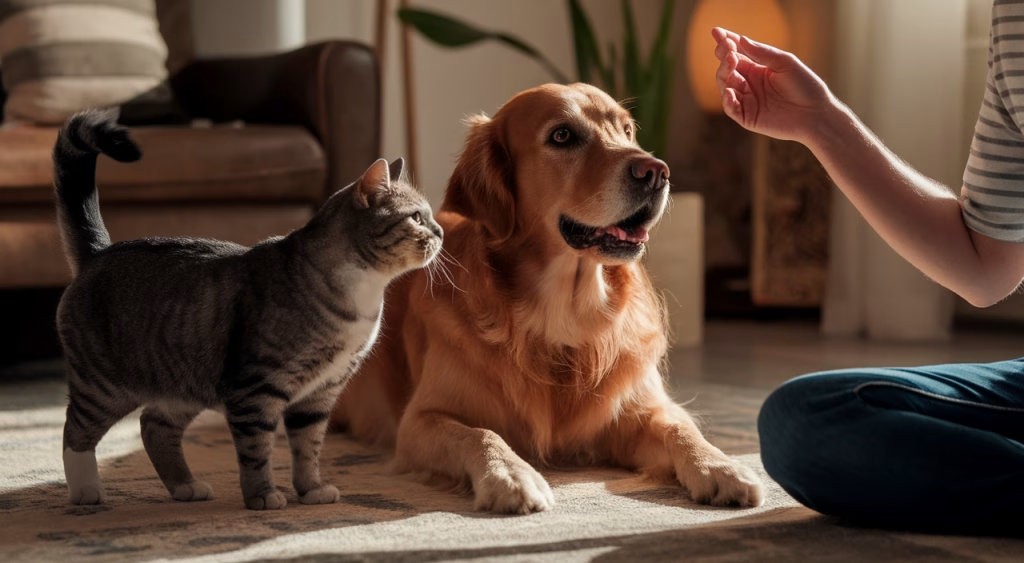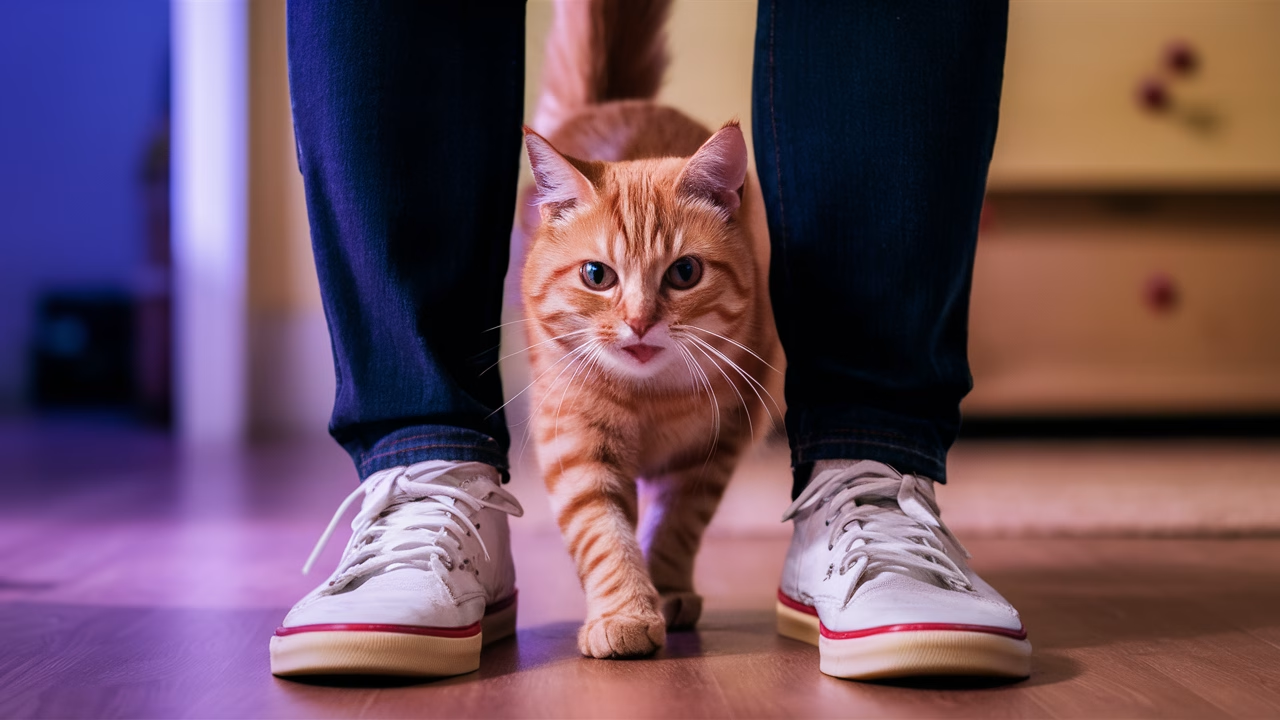What Is My Pet Really Trying to Tell Me With Strange Behavior?
Your pet’s strange new habit—like staring at you for 30 seconds without blinking or suddenly hiding under the bed—might not be just quirky behavior. It could be part of a sophisticated pet communication system designed to alert you to discomfort, anxiety, or even a medical emergency. Learning to decode these signals can lead to faster interventions and a stronger bond with your furry friend.
- TL;DR:
- Pet communication isn’t random—it’s a language based on instinct and behavior.
- Dogs pacing often signals pain, needing to relieve themselves, or spotting danger.
- Cats hiding signals distress, illness, or fear—not just moodiness.
- Abnormal grooming, vocalizations, and sleep changes can point to deeper health issues.
- Appetite and bathroom behavior changes are urgent indicators of emotional or physical distress.
- This guide helps you decode cues of pet anxiety, distress, and wellness.
Before diving in, here’s an expert video that explores the uncanny ways our pets send silent alerts:
The Significance of Pet Behavior
Communication Through Actions
Animals don’t use words, but their actions form a powerful language. From subtle ear twitches to dramatic stares, your pet’s movements often reveal more than meets the eye. Understanding animal behavior requires us to step into their world of instinct and survival. When you see your dog behavior patterns like pacing tirelessly or cat behavior like weaving between your legs, they’re trying to say, “Something’s wrong!”
Unlike humans, animals lean heavily on body language and ritualistic behaviors. A dog that circles before lying down isn’t just being quirky—it’s obeying ancient instincts for comfort and safety. Each behavior, no matter how random it seems, serves a purpose in pet communication—often a communicative one.
Signs of Distress
One of the most overlooked aspects of pet communication is recognizing emotional or physical distress through subtle changes in routines and temperament. Pets rarely show weakness unless absolutely necessary. In the wild, signs of weakness spell danger—which is why your furry companions hide behaviors until they escalate.
| Behavior | Possible Meaning |
|---|---|
| Pacing | Pain, anxiety, need to eliminate |
| Hiding | Illness, stress, or fear |
| Sudden aggression | Pain, protectiveness, overstimulation |
| Vocal changes | Confusion, discomfort, cognitive issues |
Interpreting Cat Behavior
Vocal and Physical Cues
Ever had your cat stare at you with an unsettling, unblinking gaze? That’s not just moodiness—it could be a trigger from their feline emergency broadcast system. Cats are particularly expressive through small physical cues and vocalizations. A chatty cat might suddenly go solemn when it’s sick, and previously quiet felines could start yowling when in pain or distress.
When a cat walks between your legs, tail upright and meowing urgently, they’re demanding attention. This cat behavior could signal hunger, sickness, or stress triggered by an environmental change. Observing if this comes with other behaviors like limping, excessive grooming, or loss of appetite can help you determine if it’s time for action.
Understanding Hiding Behaviors
Cats hide to stay safe. A sudden preference for dark corners or vanishing under beds is not an attitude problem—it’s a survival behavior. Often, this means illness or extreme anxiety. In fact, many life-threatening conditions go undiagnosed because a cat simply ‘doesn’t seem like themselves.’
The familiarity of your cat’s hiding spots, combined with any recent behavioral changes, could help you decide if this is a mood change or a medical emergency that needs prompt attention.
Deciphering Dog Actions
Pacing and Vocalizations
One of the most misunderstood forms of dog behavior is pacing. While some pet owners assume their dogs are just energetic or restless, excessive pacing often means something’s off. It could be a sign of gastrointestinal discomfort, nervousness, or even a urinary tract infection.
Dog vocalizations are another brilliantly complex form of pet communication. Whining by the door likely means “I need to go,” while sudden barking at night could indicate sensory changes or cognitive decline, especially in senior dogs. These patterns of dog behavior help us decode what they’re really trying to say.
Changes in Social Behavior
When a social dog stops greeting you exuberantly or no longer plays with their favorite toy, take notice. This isn’t sulking—it often reflects changes in health or mood. Dogs may become clingy when anxious or distant when in pain. Understanding these shifts in dog behavior helps you respond appropriately to their needs.
Recognizing Pet Health Concerns
Appetite Changes and Bathroom Habits
Eating patterns tell powerful stories in pet communication. A pet who suddenly refuses food isn’t picky—they’re possibly unwell, stressed, or in dental pain. Cat behavior like avoiding food placed near water bowls stems from ancient instincts that warn against possible contamination—a survival mechanism passed down from wild ancestors.
Changes in bathroom habits also rank high on the concern list. Dogs who urinate in unfamiliar spots or cats who abandon their litter box aren’t being rebellious—they’re waving flags of distress. It may be anxiety, illness, or something as simple as a litter box that’s not clean enough for feline standards.
Sleep Patterns and Grooming
Sleep disruption or location shifts in your pet’s patterns could be subtle SOS messages. A dog that can’t settle or a cat abandoning a favorite sunny sleep spot might be in discomfort. These changes in animal behavior often indicate underlying issues that need attention.
Grooming behaviors tell us a lot as well in pet communication. Overgrooming can lead to bald patches—a red flag for skin irritation, allergies, or anxiety. Meanwhile, lack of grooming in cats almost always points to depression or illness. These aren’t vanity issues—they’re warning signs embedded in cat behavior patterns.
| Behavior | Communication Signal |
|---|---|
| Stops grooming | Depression, illness |
| Overgrooming | Stress, skin irritation |
| New sleep locations | Pain, discomfort, temperature sensitivity |
Comparing Cat and Dog Communication Styles
| Behavior | Dog Interpretation | Cat Interpretation |
|---|---|---|
| Excessive vocalization | Separation anxiety, confusion | Illness, urgency, cognitive issues |
| Lack of grooming | Less frequent (may lick localized pain) | Serious depression or sickness |
| Social withdrawal | Pain or emotional distress | Instinctual hiding when ill |
| Pacing or circling | Bathroom need, anxiety | Stress or expression of agitation |
How to Read Horse Facial Expressions: Complete Guide to 17 Equine Emotions
Conclusion
Your pet doesn’t speak your language—but they’ve mastered behavior as their dialect. By training ourselves to read their pacing, hiding, vocalizations, and sleeping habits, we open a gateway to better pet well-being and stronger bonds with our furry companions.
What might look like quirky animal behavior to us can actually be a distress signal so urgent that in the wild, it could mean life or death. From food strikes to destructive behavior, every detail in pet communication tells a story if you know how to listen.
The gift of being human is that we can learn. Let’s use that gift to meet our pets halfway in understanding their cat behavior and dog behavior—so they never have to scream in silence again.
Frequently Asked Questions
- Why is my dog pacing all the time? Pacing in dogs can mean pain, anxiety, or an urgent bathroom need. This dog behavior should not be ignored, especially if it’s new or persistent.
- Is my cat hiding because it’s just shy? Prolonged hiding in normally social cats is usually a red flag for illness, injury, or emotional distress—not typical cat behavior.
- What does sudden excessive grooming mean? Both cats and dogs may overgroom due to allergies, stress, or skin conditions that need veterinary evaluation.
- Can vocal changes mean my pet is sick? Yes. A quiet pet becoming loud—or vice versa—often indicates cognitive or physical changes worth a vet visit.
- How do I tell if it’s a medical emergency? Sudden appetite loss, bathroom accidents, hiding, or limping warrant immediate professional attention.
- Should I worry if my dog suddenly avoids certain rooms? Yes. This dog behavior could suggest anxiety, past trauma, or neurological issues affecting perception.
- What’s the best way to monitor subtle behavior shifts? Keep a daily log. Noticing patterns over time helps differentiate normal quirks from serious changes in pet communication.




